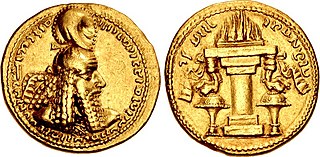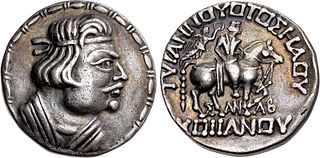
Heraios was apparently a king or clan chief of the Kushans, one of the five constituent tribes of the Yuezhi, in Bactria, during in the early 1st century CE.

Vonones was an Iranian king, who ruled Sakastan from 75 BCE to 57 BCE. During the latter part of his reign, he extended his rule as far as Taxila in north India, minting coins with the title of King of Kings. Vonones was a rival of the first Indo-Scythian monarch Maues, who also claimed the title of King of Kings. Both of them fought for power over the regions of Arachosia, the Kabul Valley, Ghadhara and Taxila.

Kushano-Sasanian Kingdom is a historiographic term used by modern scholars to refer to a branch of the Sassanid Persians who established their rule in Bactria and in northwestern Indian subcontinent during the 3rd and 4th centuries at the expense of the declining Kushans. They captured the provinces of Sogdiana, Bactria and Gandhara from the Kushans in 225 AD. The Sasanians established governors for the Sasanian Empire, who minted their own coinage and took the title of Kushanshas, i.e. "Kings of the Kushans". They are sometimes considered as forming a "sub-kingdom" inside the Sasanian Empire. This administration continued until 360-370 AD, when the Kushano-Sasanians lost much of its domains to the invading Kidarite Huns, whilst the rest was incorporated into the imperial Sasanian Empire. Later, the Kidarites were in turn displaced by the Hephthalites. The Sasanians were able to re-establish some authority after they destroyed the Hephthalites with the help of the Turks in 565, but their rule collapsed under Arab attacks in the mid 7th century.

Spalagadames was an Iranian king, who ruled Sakastan in the last quarter of the 1st-century BC after his father Spalahores, who was himself possibly a brother of king Vonones. Spalagadames has been suggested by the Iranologist Khodadad Rezakhani to be the same figure as the first Indo-Parthian king Gondophares.

Khingila I was the founding king of the Hunnic Alkhan dynasty. He was a contemporary of Khushnavaz.
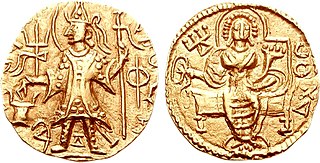
Vāsishka was a Kushan emperor, who seems to have had a short reign following Kanishka II.

Kipunada, also Kipanadha, was probably the last ruler of the Kushan Empire around 335-350 CE. He is known for his gold coinage. He succeeded Shaka I. Kipunada was probably only a local ruler in the area of Taxila, in western Punjab, and he may have been a subject of Gupta Emperor Samudragupta.
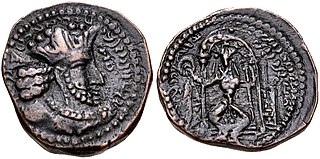
Kushanshah was the title of the rulers of the Kushano-Sasanian Kingdom, the parts of the former Kushan Empire in the areas of Sogdiana, Bactria and Gandhara, named Kushanshahr and held by the Sasanian Empire, during the 3rd and 4th centuries CE. They are collectively known as Kushano-Sasanians, or Indo-Sasanians.

Sarpedones was an Indo-Parthian king. He was a lieutenant or kinsman of Gondophares, and ruled Sakastan, where he had coins minted with the title of King of Kings.

Sanabares was an Indo-Parthian king. He was the last Indo-Parthian king to rule in both Sakastan and south Arachosia, as the Kushans under Wima Kadphises made inroads into Indo-Parthian territory.
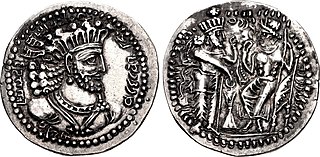
Peroz I Kushanshah was Kushanshah of the Kushano-Sasanian Kingdom from 245 to 275. He was the successor of Ardashir I Kushanshah. He was an energetic ruler, who minted coins in Balkh, Herat, and Gandhara. Under him, the Kushano-Sasanians further expanded their domains into the west, pushing the weakened Kushan Empire to Mathura in North India.

Ardashir IKushanshah, was the first of the Kushano-Sasanids Kushanshas ruler, in effect a governor of the Sassanid Empire for the eastern regions of Sogdiana, Bactria and Gandhara which had been captured following the decline of the Kushans in 225 CE.

Hormizd II Kushanshah, was Kushanshah of the Kushano-Sasanian Kingdom from 300 to 303. Like his predecessors, he was, in effect a governor of the Sasanian Empire for the eastern regions of Marw, Tukharistan and Gandhara which had been captured following the defeat of the Kushan Empire in 230. Since the reign of his predecessor Hormizd I Kushanshah, copper drachms were minted with the names of two local governors, Meze and Kavad.

Mehama, ruled c.461-493, was a king of Alchon Huns dynasty. He is little known, but the Talagan copper scroll mentions him as an active ruler making a donation to a Buddhist stupa in 492/93. At that time, it is considered that the Alchon Huns were firmly in charge of the Buddhist region around Taxila, but had not yet started to conquer the Indian mainland.

Peroz II Kushanshah was the penultimate Kushanshah of the Kushano-Sasanian Kingdom from 303 to 330. He was the successor of Hormizd II Kushanshah.

Peroz, was according to modern scholarship an early Kidarite ruler in Gandhara, right after the end of Kushano-Sasanians.

Kirada, is considered by modern scholarship as the first known ruler of the Kidarite Huns in the area of Gandhara in northwestern India, possibly at the same time as another Kidarite ruler named Yosada.

Mahi was a Kushan ruler, whose reign is dated to circa 300-305 CE. He probably succeeded Vasudeva II, and his successor was Shaka. Mahi was among the very last Kushan Emperors, before they were overrun by the Kidarites.

The Sasanian coinage of Sindh refers to a series of Sasanian-style issues, minted from 325 to 480 CE minted in Sindh, in the southern part of modern Pakistan, with the coin type of successive Sasanian Empire rulers, from Shapur II to Peroz I. Together with the coinage of the Kushano-Sasanians, these coins are often described as "Indo-Sasanian". They form an important part of Sasanian coinage.

![]()
![]()
![]()












